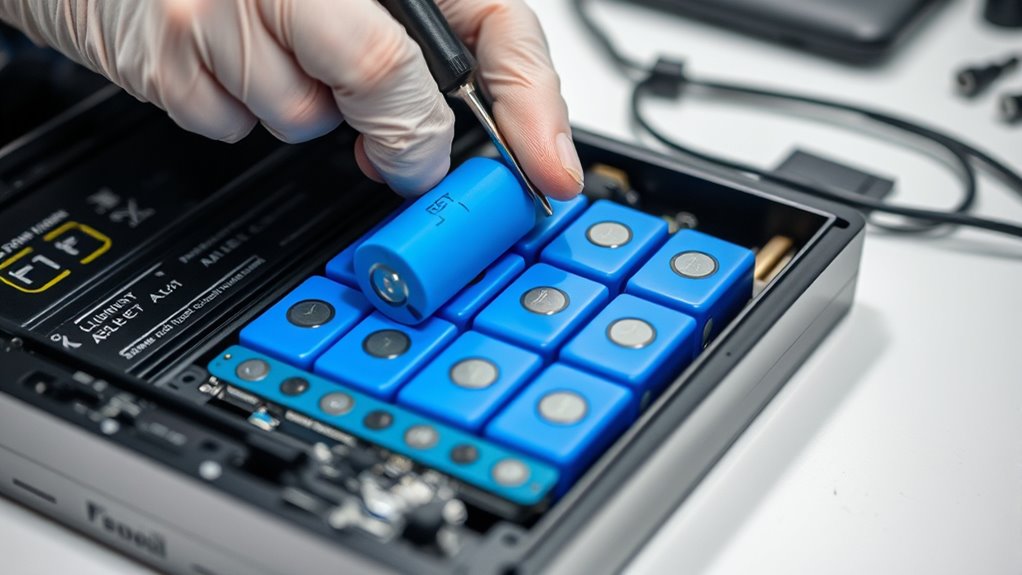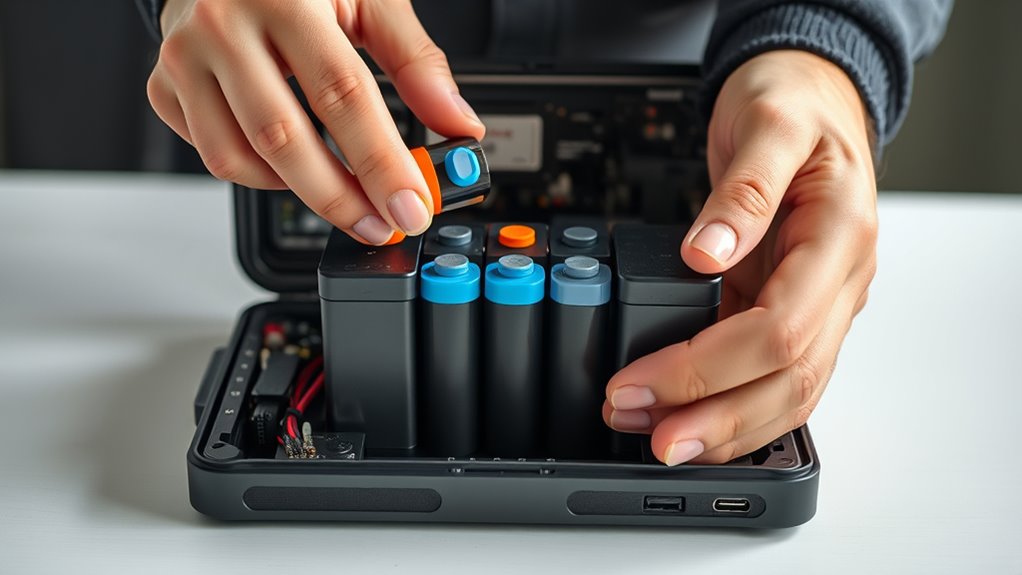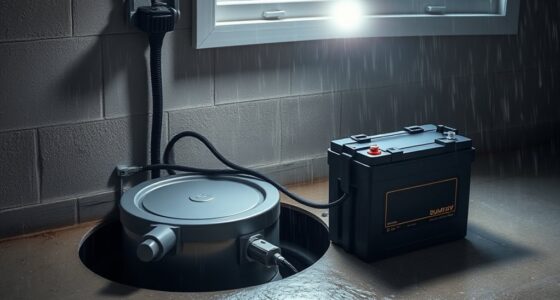To replace the batteries in your power station, start by turning it off, unplugging it, and opening the casing carefully, following the manufacturer’s instructions. Safely disconnect and remove the old batteries, inspecting for damage and ensuring they’re fully discharged. Install new cells that match your device’s specifications, securely connecting and securing them before closing the case. Always work in a safe, ventilated space and double-check your connections—continuing this guide will provide detailed steps for a successful swap.
Key Takeaways
- Turn off and unplug the power station, then open the casing following manufacturer instructions to access the battery compartment.
- Carefully disconnect old batteries, noting wiring methods, and inspect for damage or leaks before removal.
- Confirm new cells are compatible, secure connections properly, and avoid damaging or puncturing the batteries during installation.
- Work in a well-ventilated area, handle batteries safely, and double-check all connections before sealing the device.
- Power on the device after reassembly to test functionality and perform regular maintenance to extend battery life.

Battery swap technology is transforming the way we think about electric vehicle charging by offering a quick and convenient alternative to traditional charging methods. This concept extends beyond vehicles and into portable power stations, where swapping out depleted cells for fresh ones can save you time and keep your devices running smoothly. If you’re interested in replacing cells in your power station yourself, it’s essential to understand proper battery maintenance and safety precautions. Handling batteries improperly can lead to damage, safety hazards, or reduced performance, so approach the task with care.
Battery swapping in power stations offers a quick, safe way to maintain device power and performance.
First, before diving into the swap, ensure your power station is turned off and unplugged from any power source. This prevents accidental shocks or short circuits. Carefully open the casing, following the manufacturer’s instructions, to access the battery compartment. When handling the cells, always wear protective gloves and safety goggles. Batteries can contain corrosive materials or residual charge, and direct contact might cause skin irritation or other injuries.
Inspect the old cells for any signs of damage, swelling, or leakage. Damaged batteries pose safety risks and should be disposed of properly according to local regulations. If the cells look fine, proceed to disconnect them carefully, noting how they are wired or secured in place. Take your time to avoid damaging connectors or other components. When installing new cells, ensure they are compatible with your power station’s specifications. Using the wrong type of batteries can lead to poor performance, overheating, or even safety hazards.
Throughout the process, keep safety precautions in mind. Avoid puncturing or crushing the cells, as this can cause dangerous chemical leaks or fires. Make sure the workspace is well-ventilated and free of flammable materials. Once the new cells are installed, double-check all connections for firmness and correctness. Before closing the casing, perform a quick inspection to ensure nothing was missed and that there are no loose wires.
In addition, understanding the importance of proper battery maintenance can help extend the lifespan of your cells and ensure safe operation. After sealing everything back up, power on your device and run a quick test to confirm everything functions properly. It’s a good idea to monitor the new cells during the first few uses to make sure they’re performing as expected. Regular battery maintenance, including keeping cells clean and stored properly, helps extend their lifespan and ensures safe operation. When done correctly, swapping cells in your power station becomes a straightforward process that saves you time and keeps your devices powered reliably. Just remember, safety always comes first, so handle batteries with respect and caution.
Frequently Asked Questions
What Safety Precautions Should I Take During Battery Replacement?
When replacing batteries, prioritize safety to prevent accidents. Always follow proper battery safety protocols, such as disconnecting power first. Wear personal protective equipment like gloves and safety goggles to shield against potential leaks or sparks. Work in a well-ventilated area, and keep flammable materials away. Handling batteries carefully diminishes the risk of injury, and taking these precautions guarantees a safe, successful replacement process.
Can I Upgrade to Higher-Capacity Cells in My Power Station?
You can upgrade to higher-capacity cells, but first check cell capacity and compatibility concerns. Confirm the new cells match your power station’s specifications, including voltage and size. Assess whether your device’s circuitry can handle increased capacity without risking damage. Always consult your manufacturer or a professional to verify compatibility, and proceed carefully to avoid safety issues or voiding warranties. Upgrading can boost performance if done correctly.
How Long Does a Typical Battery Swap Process Take?
A typical battery swap takes about 10 to 30 minutes, depending on your power station model. During this process, you’ll remove the used cells and install new ones, which helps sustain your battery’s overall health and prolongs its battery life. A quick swap ensures minimal downtime and maintains fast charging speed, so you can keep your devices powered up efficiently without sacrificing performance or longevity.
Are There Compatibility Concerns With Different Battery Brands?
It’s no coincidence that you’re asking about battery brand compatibility; it’s a common concern. You should know that cross-brand interchangeability isn’t always guaranteed because different brands may use varying chemistries or connectors. To avoid issues, always check if your power station supports specific battery brands or models. Ensuring compatibility helps maintain safety and performance, so don’t overlook manufacturer guidelines when swapping batteries.
What Tools Are Essential for a Safe DIY Battery Swap?
When swapping batteries yourself, you need essential tools like insulated screwdrivers, gloves, and safety goggles for protection. A multimeter helps check battery voltage and guarantee proper connections, while a thermal regulation device prevents overheating during the process. Proper battery management is vital to avoid damage, so work in a dry, ventilated area and handle batteries carefully. This guarantees a safe, efficient DIY swap, preserving your power station’s performance.
Conclusion
Remember, a stitch in time saves nine. By swapping your power station’s batteries yourself, you extend its life and save money. Just follow the simple steps, handle the cells carefully, and stay safe. With a little effort, you can keep your device running smoothly and avoid costly replacements. Don’t wait for problems to escalate—take control now. Your proactive approach guarantees reliable power whenever you need it most.









